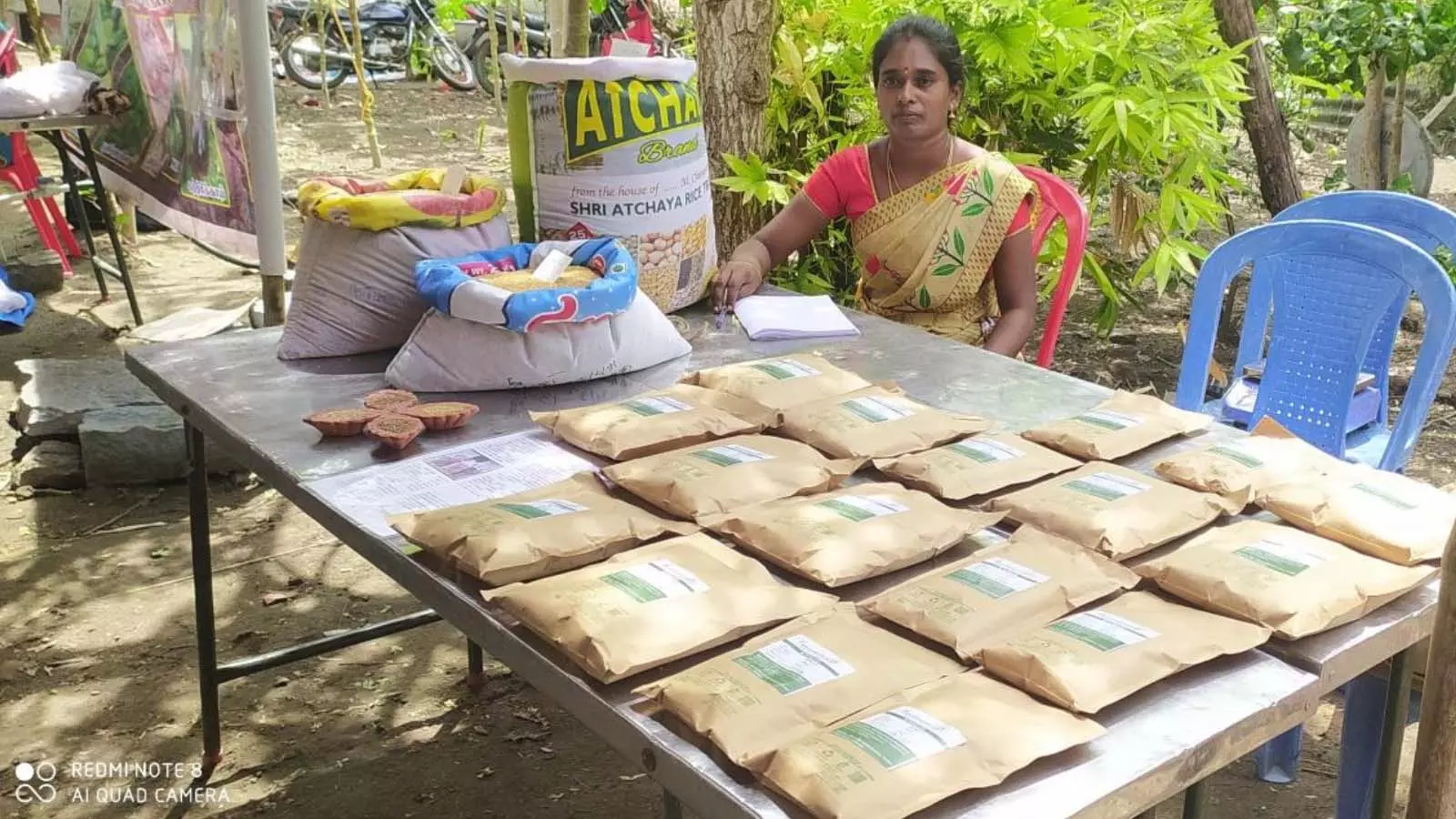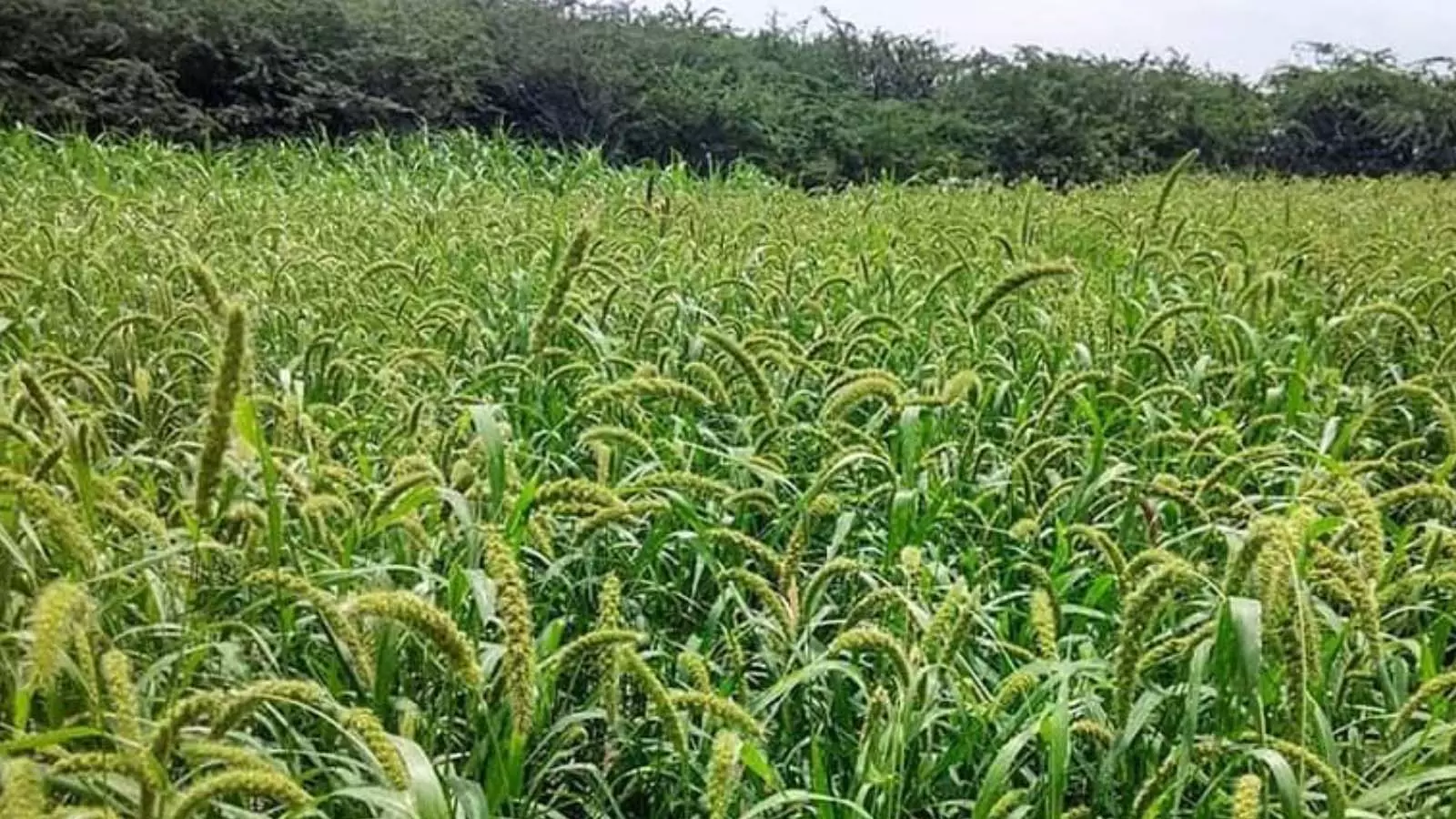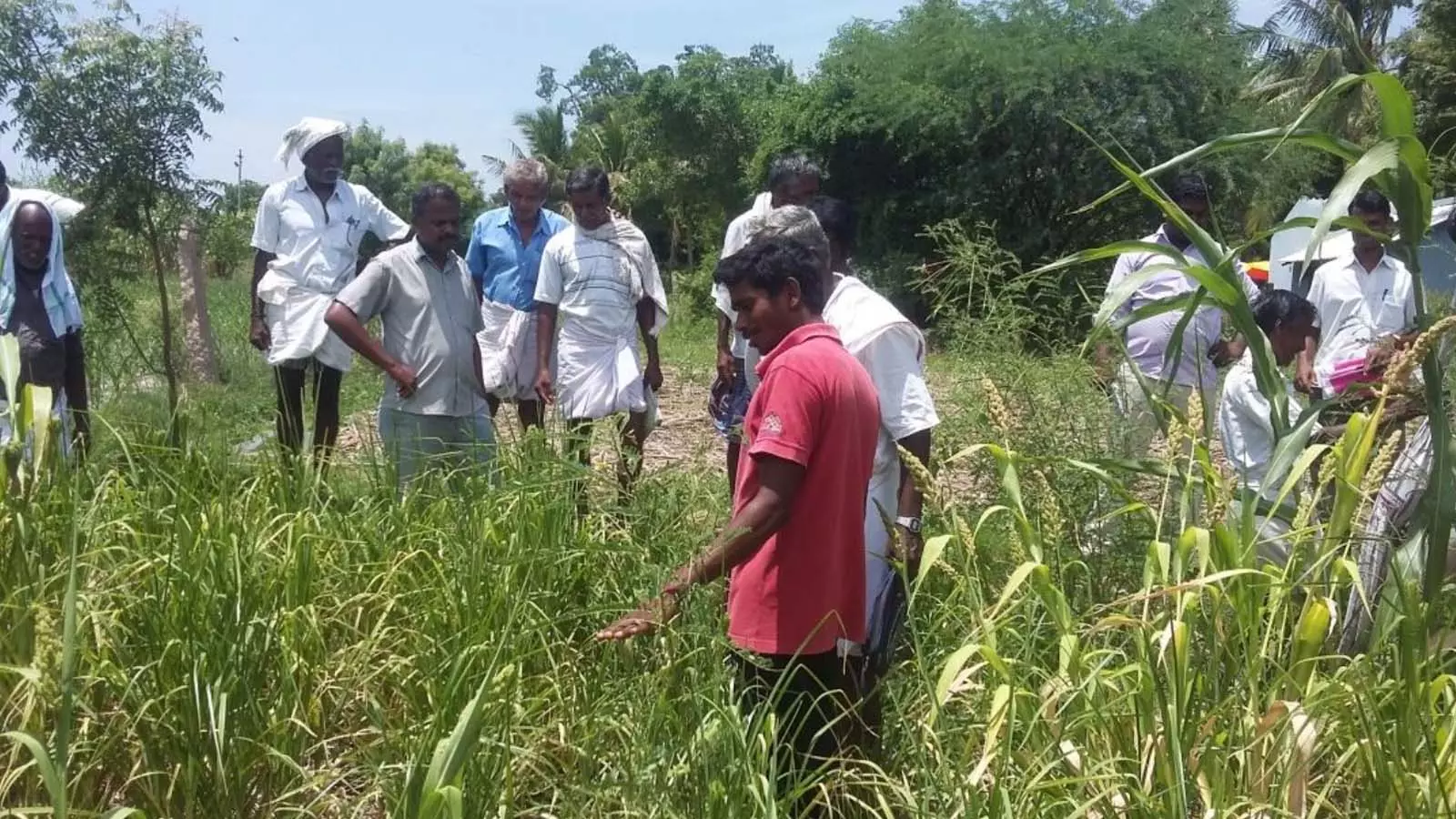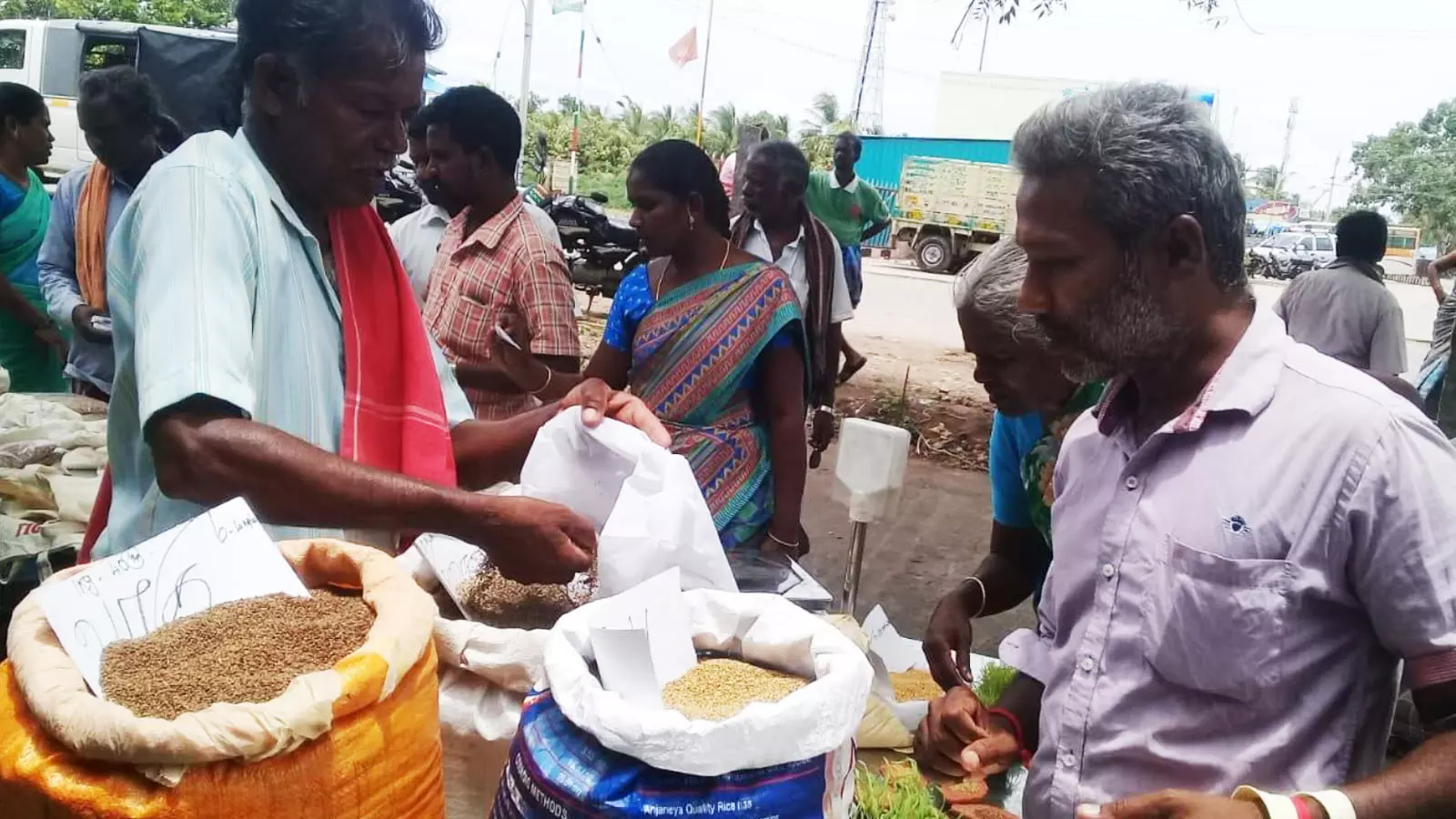
- Home
- India
- World
- Premium
- THE FEDERAL SPECIAL
- Analysis
- States
- Perspective
- Videos
- Sports
- Education
- Entertainment
- Elections
- Features
- Health
- Business
- Series
- In memoriam: Sheikh Mujibur Rahman
- Bishnoi's Men
- NEET TANGLE
- Economy Series
- Earth Day
- Kashmir’s Frozen Turbulence
- India@75
- The legend of Ramjanmabhoomi
- Liberalisation@30
- How to tame a dragon
- Celebrating biodiversity
- Farm Matters
- 50 days of solitude
- Bringing Migrants Home
- Budget 2020
- Jharkhand Votes
- The Federal Investigates
- The Federal Impact
- Vanishing Sand
- Gandhi @ 150
- Andhra Today
- Field report
- Operation Gulmarg
- Pandemic @1 Mn in India
- The Federal Year-End
- The Zero Year
- Science
- Brand studio
- Newsletter
- Elections 2024
- Events
Millets in, middlemen out: Tamil Nadu’s Veppur village women lead millet revolution

In the drought-prone, climate-vulnerable lands of Perambalur district in Tamil Nadu, a quiet revolution is brewing, led by a determined collective of women farmers. Once infamous for being the most climate-vulnerable district in the state, with Veppur block declared one of Tamil Nadu's most backward, Perambalur is witnessing a powerful transformation through the revival of millets.The genesis...
In the drought-prone, climate-vulnerable lands of Perambalur district in Tamil Nadu, a quiet revolution is brewing, led by a determined collective of women farmers. Once infamous for being the most climate-vulnerable district in the state, with Veppur block declared one of Tamil Nadu's most backward, Perambalur is witnessing a powerful transformation through the revival of millets.
The genesis of the movement is rooted in crisis. Rain-fed lands here had long abandoned traditional crops like Varagu (Kodo Millet), Cholam (Sorghum), and Thinai (Foxtail Millet) in favour of Bt. Cotton and High-Yielding Varieties (HYV) of maize. These crops, promoted for their commercial potential, came with a heavy price like dependency on pesticides and insecticides, environmental degradation, and rising farmer deaths due to pesticide exposure. There were cases of farmers who had died from inhaling pesticides during spraying. As millets disappeared from both farms and plates, malnutrition especially among women and children rose alarmingly.

Millet rice being sold in plastic-free packets
Forty-eight-year-old K. Banumathi of Veppur was one of the beginners to take a step forward to put an end to the deaths of farmers and to repair the broken chain of traditional millet production and food security of the families of farmers in her village.
“It was in this landscape of broken food systems, economic distress, and climate uncertainty that the Barefoot Academy of Governance (BA) stepped in. Social activists and like-minded people who developed the BA organisation united farmers like us. In 2015, they began a grassroots initiative with small farmers like me to encourage millet cultivation using organic methods. Revival of millet farming also helped in growing climate-resilient, eco-friendly and nutritionally rich alternatives for us,” Banumathi told The Federal.

Thinai-Foxtail Millet
Ten years later, the results speak for themselves. By 2024-25, 227 farmers like Banumathi were cultivating over 425 acres of millets across Perambalur, with a total procurement volume crossing 1.6 lakh kg. What began as a modest organic farming trial is now a full-fledged farmer-led movement that is transforming Veppur village.
Participatory pricing breaks market chain
Another farmer S. Sumathi, explained how the economic development increased the economy and improved the living standard of the farmers in the village.
“One of the movement’s most powerful interventions has been participatory price fixing. Every season, we document every rupee spent from seed to harvest including their own labour and land costs. After harvest, collective meetings are held where farmers jointly determine a fair selling price based on actual expenditure and yield. This transparent, community-driven pricing system routinely ensures rates well above prevailing market prices bringing dignity back to farming and freeing cultivators from exploitative middlemen,” said Sumathi.

Farmers being trained in millet cultivation
This pricing model also laid the foundation for the creation of the Nammazhvar Iyarkai Sirudhaniya Uzhavar Urpathiyalar Kuzhu, a women-led farmer collective formed in 2020. Named after the celebrated organic farming pioneer Nammalvar, the society now has 30 active members and an 11-member executive committee. Its aim goes beyond agriculture. It also promotes community water governance, ecological restoration, and sustainable development in Veppur village, which was once a most vulnerable block in the state.
Government and private support
This transformation would not have been possible without strategic partnerships. Recognising the work of the millet farmers, the State Planning Commission of Tamil Nadu, under the State Balanced Growth Fund, funded key interventions between 2020 and 2021. This enabled procurement from 61 farmers across 115 acres and the establishment of a millet processing unit in Nannai village.
This facility, functional since September 2021, includes de-stoners, hullers, a flour mill and a continuous packing machine. It helps process millets into rice, flour, and broken grains, ready for both local and urban markets.
Private sector partnerships also played a crucial role. Since 2017, Earth 360 Eco Ventures, has procured millets from Perambalur farmers at prices Rs 7 to Rs 9 higher than market rates. Their sister concern, Millet Machines & Tools (MMT), donated a mobile multipurpose grader to improve on-farm grain quality. This grader, upgraded recently, enables farmers to clean and grade produce at the farm gate, ensuring premium quality and price.
Additional support from Development Association for Needy Elevation (DANE)and Protech Impact Foundation Inc brought in critical machinery de-hullers, pulverisers, and roasters. This allowed the Nammazhvar Society to diversify into value-added products like roasted kurunai and husk powder (Thavidu), expanding income streams for women farmers.
Data tells the success story
The numbers tell a remarkable story of scale and resilience. From 1,350 kg of millet procured in 2015–16 to over 48,297 kg procured in the current 2024–25 season, this initiative has shown steady growth despite erratic weather and funding challenges. The total procurement across 10 years now exceeds 1.63 lakh kg from nearly 200 farmers, with actual participation estimated to be higher. But it hasn’t been without hurdles.
Despite strong momentum, Nammazhvar Society faces pressing challenges. The average yield remains modest at 500–600 kg per acre, and there’s a clear need to identify and scale up best practices in organic millet farming from sowing to harvesting.
Timely procurement is also crucial. “If we delay procurement by even a few weeks post-harvest, we see farmers switching back to conventional crops the next year,” says another farmer Chitra. She said mobilising funds for immediate post-harvest buying remains a perennial challenge.
“Processing is another bottleneck. While the unit produces high-quality output, the physical drudgery for workers remains enormous. Introducing basic automation elevators, upgraded graders, and training could dramatically ease workloads and improve efficiency. Electricity costs too are eating into margins. We are now exploring a hybrid solar system to reduce power bills (currently around ₹3,500 every two months) and ensure uninterrupted processing despite power cuts,’’ she explained.
Another key frontier is local consumption. Ironically, most processed millets from Perambalur are sold in urban markets. Nammazhvar Society is planning an awareness campaign to promote local consumption of millets, targeting schools, anganwadis, and local kitchens. After all, the revival of millets must begin at home.

Farmers selling millets at the seed festival
“Couple of anganwadis and schools cook millet meals these days. They buy from us. This also encourage many students to consume millet food at home. When they are aware about their food is coming from local farmers, they would continue to use millets in their life,” said Banumathi.
Towards equitable, sustainable future
Environmentalist Arul Selvam says the success story of Veppur women is not just about better crops, but about restoring agency to women farmers, decoupling rural economies from exploitative market systems, and reviving food cultures that nourish both people and planet.
“Their plans for value addition and to develop millet-based snacks, ready-to-eat foods, and mixes that can generate jobs and reduce waste (especially of broken grains). The Society aims to train its women members in business skills and leadership, so they can eventually manage the entire value chain from sowing seeds to selling snacks. This is not merely a story of agricultural revival, it’s a model of climate resilience, community governance, and women’s empowerment, rooted in tradition but forward-looking in ambition,” said Arul Selvam.
